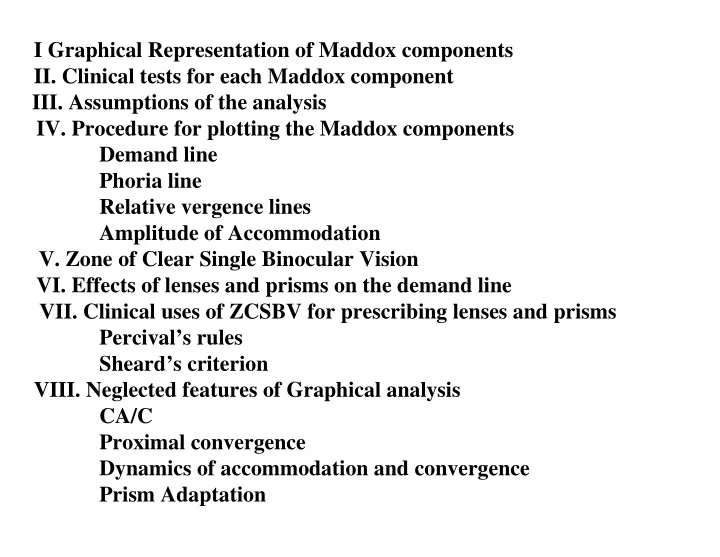

I Graphical Representation of Maddox components II. Clinical tests for each Maddox component III. Assumptions of the analysis IV. Procedure for plotting the Maddox components Demand line Phoria line Relative vergence lines Amplitude of Accommodation V. Zone of Clear Single Binocular Vision I. VI. Effects of lenses and prisms on the demand line VII. Clinical uses of ZCSBV for prescribing lenses and prisms Percival’s rules Sheard’s criterion VIII. Neglected features of Graphical analysis CA/C Proximal convergence Dynamics of accommodation and convergence Prism Adaptation
Midterm examination in 1 week (Thursday, February 14) covering the first 3 weeks of lectures and labs. About 15 multiple choice questions from each lecture. See website for examples of a prior midterm. Calculation problems from lecture and lab material Graph the Zone of Clear Single Binocular Vision This material wont be covered on the final. This is the final for this part of the course.
–Excellent section on Graphical Analysis in – Primary Care Optometry –by Theodore Grosvenor ( Pg 338 - 347 )
Graphical Analysis (GA): Assumptions: GA is based on the linear sum of 3 Maddox components and accommodation amplitude –Fusional (disparity) vergence –Accommodative vergence –Tonic vergence (static) - GA doesn’t consider proximal vergence
Five Independent Variables in Graphical Analysis • Distance Phoria – Measure of the tonic vergence which brought the eyes from the anatomical position of rest to the physiological position to rest • Near Phoria – Measure of the accommodative convergence – Ideal case scenario: AC/A ratio of 6:1 is the Demand line • Base Out to Blur – Measure of the limits of positive fusional vergence system • Base In to Blur – Measure of the limits of negative fusional vergence system
Zone of Clear Single Binocular Vision (ZCSBV): ZCSBV describes all possible combination of accommodation and convergence stimuli that the oculomotor system can respond to and achieve clear (focused) single (fused) binocular vision. 2-D Plot of the 5 independent variables produces a parallelogram. X axis = convergence responses ( ∆) Y axis = accommodative stimulus (D)
PRA NRA
1:1 - Demand Line: Combinations of accommodation and convergence stimuli that are matched for viewing distance. It represents demands on accommodation and convergence under natural viewing conditions.
Phoria Line: Phoria = separation between the phoria line and demand line. Predicts the phoria at all viewing distances. The slope = 1/(calculated AC/A) –Steeper the slope, lower is the AC/A ratio –Flatter the slope, higher is the AC/A ratio
PRC & NRC • PRC (Positive Relative Convergence) – Measure of Convergence ability (Blur : Break : Recovery) – Blur: Indicates end of the fusional convergence reserve – Break: Indicates end of fusional and accommodative convergence reserve – Recovery: Indicates activity of the tonic vergence system • NRC (Negative Relative Convergence) – Measure of Divergence ability (Blur : Break : Recovery) – Blur: Indicates end of the fusional divergence reserve – Break: Indicates end of fusional and accommodative divergence reserve – Recovery: Indicates activity of the tonic vergence system • NRC has a blur point only at near. For distance NRC shows a direct break point
Accommodative Amplitude Base Phoria Demand Base In Line Line Out Limit Limit Base in Base Out CONVERGENCE (DEG.)
ZCSBV ortho 2 exo Far PRC 6/13/10 8 15/12
Blur and Break points during measures of the fusional vergence range. PRC & NRC BI Blur point BO Break point Begin -AC BO Blur point Begin +AC BI Break point
Uses of ZCSBV: Predict the range of natural conditions that can be fused and seen singly. Wherever the demand line is outside the ZCSBV, there is either strabismus or blur that can not be corrected without optical aids. Predict the affects of lenses and prisms on the phoria by moving the demand line to be closer to the phoria line.
BI - lens BO + lens Lenses and Prisms move the demand line. They change the stimulus for CSBV
Diagnostic features: Narrow ZCSBV suggests a sensory problem like suppression or a vertical phoria. Treat sensory problems with eye exercises (Orthoptics) Tilted ZCSBV reveals a high AC/A ratio. Bifocals for near work are a good solution. Demand line is close to the lateral limits of ZCSBV. May need lenses or prisms.
How do we prescribe based on ZCSBV Percival’s criteria: Don’t prescribe if there are no patient problems. Take a good case history to reveal any. Correct all vertical phorias before measuring horizontal fusion ranges. Demand line should be in the middle third of the ZCSBV. Rx prism or lenses to meet this criterion.
Middle third of ZCSBV = Zone of comfort
Things not considered by Graphical Analysis (GA): CA/C ratio Proximal Convergence Prism and Lens adaptation Dynamic properties of AC/A and CA/C Supplement GA with measures of Fixation Disparity and the associated phoria.
Take-Home Example Orthophoric 2 ∆ Exophoric Near Far PRC 8 Blur / Break / Recovery 15 / 12 6 / 13 / 10 Near Far NRC 6 Blur / Break / Recovery 10 / 8 x / 8 / 6 6D x x x
Use of ZCSBV • Predicts the range of natural viewing conditions that can be fused and seen singly • If the demand line is outside the ZCSBV, it indicates either a blur or a diplopia that cannot be corrected by the visual system • Predicts the effect of lenses and prisms on the binocular vision system
The End
Recommend
More recommend